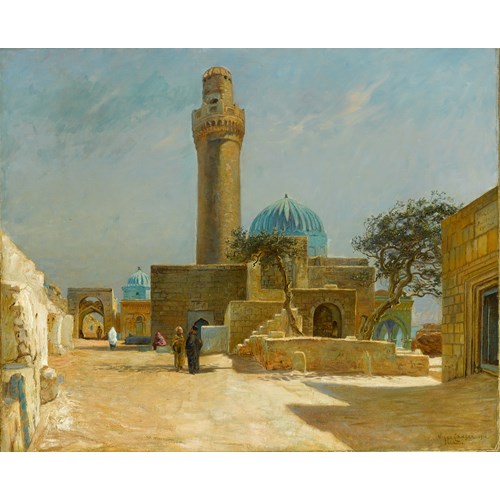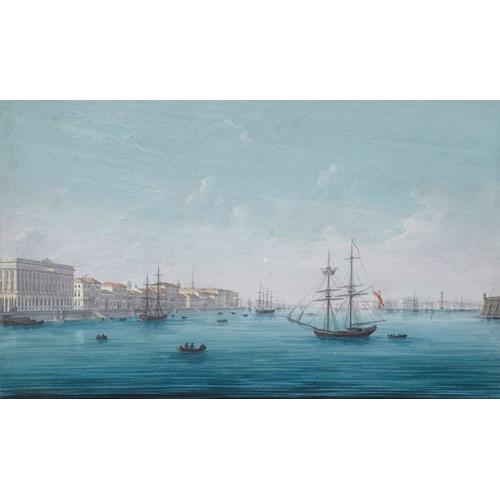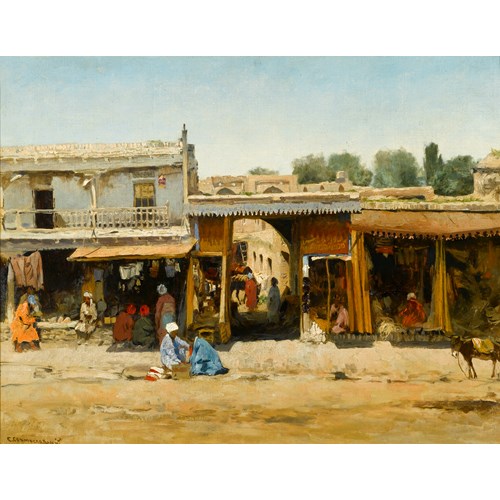Marketplace
The Close of the Day
George Cole
The Close of the Day
Date 1878
Epoque 1850-1900, 19th century
Origine England
Medium Oil on canvas
Dimension 61 x 91.4 cm (24 x 36 inches)
Under the setting sun a couple move to the side of the road, in order to allow the horse-drawn wagon to pass them by, before they can continue their weary homeward journey. The three horses, pulling the wagon laden with hay, seem to be struggling uphill and contribute to the general mood of lethargy and fatigue throughout the work. A dog pads along in front, whilst a small flock of sheep watch the group pass by. The figures are set in a gently undulating rural landscape, covered in trees and shrubs, which stretches far into the distance. The only signs of human life in this vast landscape are the roughly hewn track and the windmill which stands atop the hill, and the expansive, isolated nature of this landscape contributes to the mood of quiet, idealised rustic life. Above this, George Cole has given over half the canvas to his depiction of the effects of the sunset on the bright blue sky. The effect of clouds glowing with their pinkish tinge is spectacular, and their delicacy contrasts effectively with the weathered, rocky beauty of the foreground.
The Close of the Day is typical of Cole’s mature work, in which he often presents his rural landscapes at sunset, giving himself the opportunity to depict the sort of beautifully coloured sky that is evident in the present work. Returning from the Fields,, painted in the last year of his life, is a fine comparable example, in which the colour of the clouds ranges from intense whites, through soft pinks, to vivid orange, whilst set against the same bright blue which can be found in the present work. The subject matter in both works is very similar; rural labourers returning home at the end of the day and it is striking in both paintings how isolated the figures feel in the vast landscapes. A delight in the relatively untouched and slightly wild landscape is clearly evident in The Close of the Day, similar to that which can seen in Timber Wagon. Timber Wagon was painted three years before the present work, and is known to depict the landscape of Harting-Coombe, near Liss in Hampshire. Cole lived in the area for many years and it seems likely that The Close of the Day also depicts this area.
Cole is greatly admired for his beautiful landscapes, mainly inspired by the scenery of the south of England, and Wales. Born in Portsmouth, he was entirely self-taught until the age of thirty, when he took some lessons from the marine artist John Wilson (1774-1855). In his early career he painted large canvas advertisements for a travelling circus and a large painting of tigers and elephants, which he painted for the Wombwell menagerie and exhibited at the Weyhill fair and Great Barthelemy Fair, attracted much attention. He spent time in Holland, and his work bears the influence of the great seventeenth-century Dutch landscape painters. In addition to his idealised landscapes, Cole was an accomplished portrait and animal painter and he exhibited regularly at the Royal Academy, the British Institution and at the Royal Society of British Artists. His son, George Vicat Cole (1833-1893), also became a prominent landscape painter, and father and son worked together until a quarrel in 1855 ended their companionship.
The Close of the Day is typical of Cole’s mature work, in which he often presents his rural landscapes at sunset, giving himself the opportunity to depict the sort of beautifully coloured sky that is evident in the present work. Returning from the Fields,, painted in the last year of his life, is a fine comparable example, in which the colour of the clouds ranges from intense whites, through soft pinks, to vivid orange, whilst set against the same bright blue which can be found in the present work. The subject matter in both works is very similar; rural labourers returning home at the end of the day and it is striking in both paintings how isolated the figures feel in the vast landscapes. A delight in the relatively untouched and slightly wild landscape is clearly evident in The Close of the Day, similar to that which can seen in Timber Wagon. Timber Wagon was painted three years before the present work, and is known to depict the landscape of Harting-Coombe, near Liss in Hampshire. Cole lived in the area for many years and it seems likely that The Close of the Day also depicts this area.
Cole is greatly admired for his beautiful landscapes, mainly inspired by the scenery of the south of England, and Wales. Born in Portsmouth, he was entirely self-taught until the age of thirty, when he took some lessons from the marine artist John Wilson (1774-1855). In his early career he painted large canvas advertisements for a travelling circus and a large painting of tigers and elephants, which he painted for the Wombwell menagerie and exhibited at the Weyhill fair and Great Barthelemy Fair, attracted much attention. He spent time in Holland, and his work bears the influence of the great seventeenth-century Dutch landscape painters. In addition to his idealised landscapes, Cole was an accomplished portrait and animal painter and he exhibited regularly at the Royal Academy, the British Institution and at the Royal Society of British Artists. His son, George Vicat Cole (1833-1893), also became a prominent landscape painter, and father and son worked together until a quarrel in 1855 ended their companionship.
Date: 1878
Epoque: 1850-1900, 19th century
Origine: England
Medium: Oil on canvas
Signature: Signed and dated 'Geo.Cole.1878' (lower right)
Dimension: 61 x 91.4 cm (24 x 36 inches)
Plus d'œuvres d'art de la Galerie









